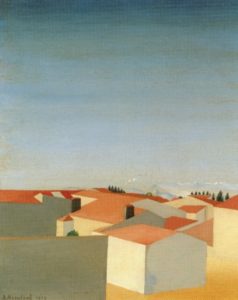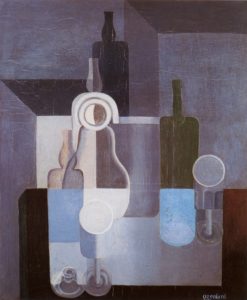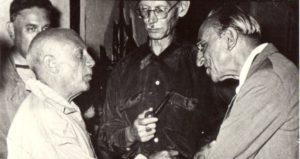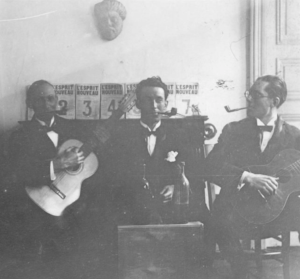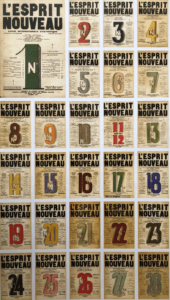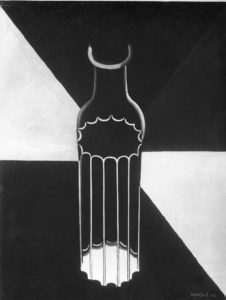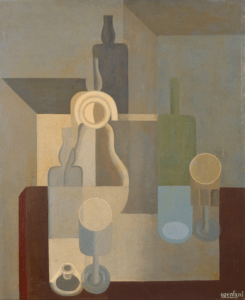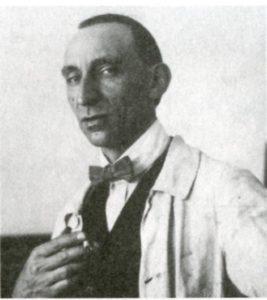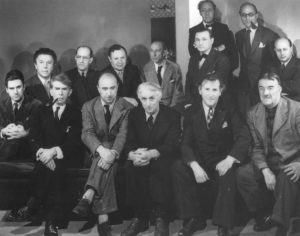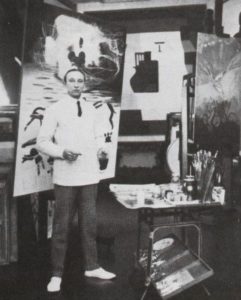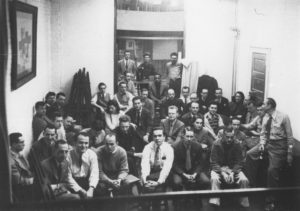Amédée Ozenfant was born on April 15, 1886 in Saint-Quentin, a small town in the north of France. The family was originally from a small Picard town not far from there called Fayet, to which the Ozenfant’s origins can be traced back to the 18th century. Traditionally the Ozenfants were craftsmen, a tradition passed down from father to son. The father, Julien, had a small, relatively successful public works office, they were an affluent rural family. The mother was from the Saugnier family, equally well known in the region. Interested in drawing, she made small enamel paintings and had a keen taste for what we refer to today as plastic arts. Marie Thérèse Ozenfant gave birth to three children, the eldest a girl of the same namesake, Marie Thérèse, the second a boy named Amédée, and the third a boy named Jean. Marie Thérèse and the youngest, Jean, loved sports and enjoyed very good health.
Amédée on the other hand, was of poor health and remained so all his life. Asthma, which was very common at the time, left him fragile and, along with his unfortunate appearance, meant that he was often mocked by his classmates. His mother was more protective of him than the others and encouraged him to take an interest in drawing, which he loved, and in music. Marie-Thérèse gave all her love and protection to this tall skinny boy with bat-like ears. “They really stuck out, which made me feel inferior later on in school because I couldn’t carry my pen behind my ear like my classmates”. Ozenfant also said of his physical appearance: “my cousin liked to say: what a nose! My poor little one, you’re smaller than your nose”.
Amédée on the other hand, was of poor health and remained so all his life. Asthma, which was very common at the time, left him fragile and, along with his unfortunate appearance, meant that he was often mocked by his classmates. His mother was more protective of him than the others and encouraged him to take an interest in drawing, which he loved, and in music. Marie-Thérèse gave all her love and protection to this tall skinny boy with bat-like ears. “They really stuck out, which made me feel inferior later on in school because I couldn’t carry my pen behind my ear like my classmates”. Ozenfant also said of his physical appearance: “my cousin liked to say: what a nose! My poor little one, you’re smaller than your nose”.
Amédée’s mother saw him as a dreamer, absent, melancholic but also capable of angry outbursts, with well-defined tastes, and “painfully emotional”. In his memoires, Amédée Ozenfant tells of how his mother raised the children observing established disciplines, a French education with Anglo-Saxon firmness. On Sundays the whole family would go to High Mass and Marie Thérèse Ozenfant considered dogmas to be symbols of superior realities inaccessible to men and above all inexplicable in words or thoughts.
Amédée started to draw, his mother never hesitating to buy him pencils, pastels, and coloring materials. He was often ill and stayed at home where he kept himself busy by drawing and learning the piano. He wanted to be a good student. Too often absent from school, he got only average grades and was pampered by his grandparents who also lived in the family home. His father, entrepreneur and tireless worker, was an example for this boy of fragile health. The father, however, found it difficult to accept his tall, sickly son’s poor grades. Ozenfant had few conversations with his strict father preoccupied by work. There was no confiding between the two. He admired and respected his father for who he was and what he undertook:
“When I was very young my father built us a country house and a small farm in Fayet. The villa plans were revolutionary for the time: basically a big long room with an atrium all along one side. It was a large house, a great place to live. I lived there happily surrounded by nature for a long time with grandmother Saugnier. The climate in this part of Picardy deserves its bad reputation: during the long months of rain, fog, general humidity and mud we dreamed of dry, clear-skied countries. Our house was sheltered on the east side by a splendid wood and, on the side where the sun set, opened onto a fairly large field … or so it seemed to us children, the historic battlefield of the 1870 war behind our garden was a constant attraction. We used to look for slingshots there. All the children liked to play war games, and Jean and I often went to shoot bows and arrows in the fields… what long dreamy hours I spent there.”
Due to Amédée’s frequent bronchitis, pleurisies, and pneumonia, he left Picardy to continue his schooling in the south of France. It was at the Dominican school of Saint Elme in Arcachon where he went for health reasons, that he truly felt the lure of the artistic vocation. Leaving Saint-Quentin was very difficult for him. Amédée Ozenfant would later say: “after so many years spent heart to heart with my sweet grandmother, no parting was ever so painful.”
At school, where he was a boarder, life was peaceful. Most of the teachers were priests but the educative approach was flexible and did not have a purely religious daily focus. “They tried to mold us into well-behaved, cultivated people with aristocratic leanings… I certainly had no cause to complain in such a magnificent place: becoming a painter for good was unavoidable”. At school he met his first drawing teacher, who taught him pastel and watercolor techniques, both rigid disciplines with no room for error. Before actually practicing he had to first “evoke colors”, to use his words, and then delicately place them on the page. He subscribed to various artistic reviews and discovered impressionism, looking to Monet, Renoir, Sisley as sources of inspiration.
He returned to Saint-Quentin in 1904. He was 18 years old and immediately signed up to the Quentin la Tour Municipal School of Drawing, where he went to class every morning. As soon as the fine weather arrived, he would take his bicycle and his easel to paint on the subject. They were the days of the first flower and landscape paintings. His parents afforded him trips abroad, which allowed him to visit many museums. His secret dream, meanwhile, was to live in Paris. “I asked my parents to allow me to live in Paris. My father consented because I promised to also study painting and architecture as he wished.” He attended the Académie de la Palette where he met many artists including Roger de la Fresnay with whom he formed a special bond. He soon became bored of studying architecture: “It was a waste of time, I had been observing construction from birth. So my parents let me pursue painting full time.”
He had his first exhibition in 1908 at the Société Nationale des Beaux Arts. From this point, Amédée Ozenfant’s family became wealthier with the passing years. His father ran the family business masterfully, affording Amédée the life of a young dandy, frequenting salons, going to concerts, to operas, travelling without money concerns. He became close friends with Rodin, as with other artists such as Sonia Terk, who would marry Robert Delaunay a few years later. He also met another Russian woman, a friend of Sonia’s named Zina Klingberg, who would become his wife. The wedding took place in Moscow. His brother Jean and his father travelled for the occasion. Amédée spent long periods in Russia between 1909 and 1913 and painted many gouaches, which would become “Le voyage en Russie ”. The Swiss collector Raoul La Roche bought them and would later donate them to the Basel Museum.
Throughout his Russian period, Amédée and his brother Jean became interested in the motorcar, the new modern challenge. They drew a car frame design for a Hispano Suiza engine. The “Hispano-Ozenfant” car proved popular at the 1911 Auto Show.
In 1913 he returned from his last trip to Moscow. After some time in Paris he travelled to Italy; first Venice, then Florence, and lastly Rome. Though generous, his father finally asked him to come home to work. In 1914 Amédée Ozenfant lost his young brother Jean. In the same year he had a chance encounter with the painter Signac, who would become a friend. Signac invited the young artist to Sisteron in Provence. Ozenfant drew many sketches of the town and the region. At various periods throughout his life, he would draw or paint Sisteron again. When the war broke out, Ozenfant returned to his hometown Saint-Quentin before moving to Paris.
A year later, wishing to do something for his war torn country while he was in the comfort of his workshop at a time when others were in the trenches, Amédée Ozenfant decided to create a review defending national values. Writers, poets, and painters collaborated in review, called “L’élan”. These intellectuals used their talent to emphasize a very French brand of patriotism. Dunoyer de Segonzac and de la Fresnaye sent him their drawings. Those remaining in Paris: Matisse, Picasso, Gleizes, Metzinger, Lhote, Apollinaire, Max Jacob, Derain and many others made regular contributions to this new review.
“Every Monday I would open my door to my friends or relatives. Every Thursday I hosted a lunch which Paul Eluard, Picasso, Max Jacob, and Matisse regularly attended. Jean Cocteau was always flitting about like a bird of luxury.”
It should be noted that Amédée Ozenfant paid particular attention to the typography and graphic design of his review. Each issue was printed using different inks and colors. He systematically took an avant-garde approach and printed some numbered copies on Japanese paper to highlight the precious nature of each issue. L’Elan. Cette dernière se veut d’avant-garde et destinée à maintenir des liens avec les autres artistes de l’époque. Il rencontre de nouveau Signac, fait la connaissance de l’Italien Gino Severini, de l’espagnol Juan Gris. Au contact de Severini il réalise avec succès des essais de typographie. Le poète Paul Fort participe au premier numéro, les peintres André Lhote, Metzinger, Derain répondent présent avec des illustrations mais également aussi avec des apports de textes comme ceux de Lhote par exemple. Ozenfant publie des dessins avec des réalisations typographiques audacieuses. Guillaume Apollinaire apporte également de larges contributions. La revue ferme ses portes l’année suivante par manque de moyens financiers et dans son dernier numéro Ozenfant avance pour la première fois le terme de purisme.
Unfortunately, only ten copies of “L’Elan” appeared due to a lack of resources. In the last issue, Amédée Ozenfant employed the term “purism” for the first time. In 1917, his father, who had never before been ill, died suddenly and his mother found herself alone, faced with the burden of managing a large fortune and a large company. However, she had no business experience and Amédée, himself a poor businessman, was of little help. Surrounded by corrupt advisors, it was not long before Marie-Thérèse Ozenfant became bankrupt, leaving Amédée Ozenfant to provide for himself. He received a small inheritance from his father, which helped to some extent but his lavish lifestyle came to an end and he was forced to learn how to manage his life.
In July 1918 Zina and Amédée Ozenfant divorced. Ozenfant withdrew into himself thinking only of his new theory: purism. He felt the need to start over and streamline his attention to reach what he called his purist dream. He even sold antique furniture bought here and there, his belongings, his grandmother’s furniture, even his dishes and pots. Wanting a complete break with the past, he burned many drawings, studies, and projects, keeping only a sofa bed and a few chairs before moving to his next abode at rue Godot de Mauroy near the Place de la Madeleine in Paris.
At that time, he frequented many artists from various disciplines: cubists such as Juan Gris, the sculptor Laurens, the architect Auguste Perret, but also the futurist Severini. Ozenfant’s artistic production underwent a transformation at the time, with his paintings between 1916 and 1918 undergoing the same avant-garde change as the “l’Elan” typographic choices. Space became fragmented into cubist, abstract and figurative elements all at once. Such pictorial offerings were unparalleled in France, perhaps he may have been influenced by Russian and suprematist painting. Auguste Perret, who he met with often and had long conversations about painting, offered to introduce him to one of his former collaborators, a young Swiss architect: “he’s a little odd, but you’ll find him interesting”….
Amédée Ozenfant recounted the encounter: :
“In May 1917 I finally met Charles-Edouard Jeanneret. A new life was beginning for him and for me. Mutual understanding gave way to friendship: we both admired the masterpieces of modern industry, and Jeanneret had an eye for beautiful artwork, particularly old work, because he was as yet unmoved by cubism, which drew only a shrug of the shoulders from him; I initiated him and he soon changed his mind, I believe, very sincerely. I received a long and moving letter from him, here are a few lines:
… I have been in state of complete confusion since I got back to drawing again. My blood drives my fingers to the arbitrary, my mind is no longer in control … my business dealings are in order, but my heart and ideas are not. I have indulged myself in impulsive habits for too long. In my state of disarray I think of your calm, nervous, clear will. It seems we are set apart by the chasm of age. I feel I am at the threshold of this study while you are already carrying it out. Looking behind me I see a thousand burgeoning intensions, strong successive sensations, and I always told myself: one day I will build. These days I am a poor bricklayer at the bottom of the earthwork, with no architectural plan! … You are … the person who seems to be carrying out with the most clarity that which is stirring restlessly within me… (Paris, June 9, 1918)
From that time he spent his weekends in Andernos on the Arcachon Basin with Jeanneret, reading his notes on purism to his new companion and offering to pool their ideas, co-sign their writing, and display their work together. Ozenfant notes in his memoires: “He accepted my proposition to work together on one condition; contrary to the alphabetical order I proposed, he wanted us to sign Ozenfant and Jeanneret, since I was the promoter, already had experience in painting and the press, and he was a newly arrived unknown Swiss immigrant. He wanted to take a discreet approach to painting so as not to risk compromising his architectural career, painting was a far less serious activity than building in his clients’ eyes.
The young Swiss had received a strict and rigorous education. His possessive mother overly protected him as a child, he would write to her at least three times a week and often go back and forth between France and Switzerland to see her. He remained very close to his intrusive mother throughout his entire life. Meeting his new friend would have an emancipatory effect on him and lead him to discover new horizons.
Charles Edouard Jeanneret took architecture classes in Switzerland in his native town of La Chaux de Fonds. There was no National School of Architecture at the time and Jeanneret got most of his training in various architectural firms in Austria, Berlin in Germany, at Auguste Perret in Paris and of course in Switzerland in La Chaux de Fonds. He never painted, apart form a few gouaches now and then. Ozenfant would teach him to paint, or more precisely, teach him painting techniques. During a stay in Paris in June 1918 Ozenfant stressed the importance of painting upon Le Corbusier. In a letter to his friend Ritter, Jeanneret wrote: “Ozenfant came up from Bordeaux last Friday, it had been months, and we spent his two days in Paris together. He said to me in the firmest tone and with a friend’s conviction: Jeanneret, you must paint. The only freedom is in painting. Will you ever create a free architectural work, will architecture ever enjoy the freedom of expression that draws forth from a man all his passion, power, his entire life? No. We must paint.” Following this, the two friends often met at rue Godot de Mauroy in Paris in Ozenfant’s workshop: “we would paint side by side every day”.
At the same time, under Ozenfant’s auspices, they would write a work together: “After Cubism”. Amédée noted in one of his letters: “... I would be very happy to combine our efforts and allow you to benefit from my experience if they can help to clarify something…”. This work began with a quote from Voltaire and was aimed at cubists or at least followers of cubism: “decadence is bred by the ease of doing things and by the laziness to do them well, by a saturation of beauty and a taste for the strange”. If Braque and Picasso are the precursors of cubism, Gleizes and Lhote the theorists, then Ozenfant and Jeanneret are its critics, attacking its “followers”, those who lack imagination, “…those seeking easy scandals … I saw Cubism sitting on a little folding seat, at the edge of time…”. Après le Cubisme. Ils travaillent dans le même temps à une présentation commune qui aura lieu rue de Penthièvre à Paris dans les locaux de la maison de couture de Germaine Bongard. Ce local prendra pour cette occasion le nom de Galerie Thomas.
Other encounters also came from his new companion, such as Paul Poiret’s sister, Germaine Bongard, with whom Ozenfant shared his life between 1918 and 1923. Though less recognized by the general public of the time by virtue of the fact that she was a woman, Germaine Bongard had very avant-garde tastes, which would also influence Amédée Ozenfant. In terms of fashion and what we now call design, Germaine Bongard made daring choices out of sync with the times. She had a fashion house in which Ozenfant was involved, first working layout and then also contributing to the collections. d’invariant.
Ozenfant opened a shop with Germaine Bongard in Bordeaux located on the Cours de Verdun called “Jove, couturier-decorator”. He was actively involved in the fashion house but met with Jeanneret regularly. They worked together on their common literary work but also on preparing a joint exhibition of their paintings and drawings. The exhibition took place on December 22, 1918 on the premises of Germaine Bongard’s dressmaking salon in Paris on Rue de Penthièvre, which was transformed into Galerie Thomas for the occasion. This exhibition could be considered the precursor of purism. The two artists used daily utensils for their still lifes, mass produced items such as simple Bordeaux wine bottles, Bourgogne wine bottles, pipes, books, bowls or pitchers that could be found in any kitchen. A cubist influence could be felt, along with a desire to break the chains and promote this new way of thinking Après le Cubisme The exhibition attracted a large audience. Public opinion proved ambivalent notwithstanding many news articles. This exhibition was considered the first since 1914 to bring something genuinely new. The public was not yet aware of the purist movement itself and remained bathed in the cubism of previous years. Ozenfant and Jeanneret were encouraged by the curiosity their work provoked and believed it to be time to go further. They met with other intellectuals such as Paulhan or Eluard, whose writing lay close to the mindset represented by purism in their view.
However, the critics were stern and treated the Ozenfant-Jeanneret pair with a degree of irony. One of them, renowned critic Vauxelles went so far as to write: “…Ozenfant and Jeanneret paint in smocks with a thin piece of material around the collar … I wish one morning … Ozenfant would say to Jeanneret : “My friend what would you say to lunch on the grass at Meudon in the company of two beautiful girls?” Another likened Ozenfant and Jeanneret to clergymen donning blinkers to take the main boulevards to avoid being tempted by pretty girls. Others saw them as grown boys confusing purism and puritanism. Their sacred union prompted much talk behind the scenes of the art world. Galerie Thomas, ils sont pour certains d’une très grande précision technique et reflètent à eux seuls le message puriste proposé par les deux artistes. Pour cela Ozenfant utilise une technique nouvelle grâce essentiellement à une mine très fine, un crayon excessivement dur appelé Koh-I-Noor 9H. L’œuvre de 1917 Bouteille, pipe et livre appelée également Table, pipe, bouteille, papier en est un exemple parfait.
In order to take their intellectual endeavor further, Amédée Ozenfant made Jeanneret a proposition to establish a review that would transmit a new way of thinking, a different way of thinking, a new philosophy rather than simply a new aesthetic, a review describing “Un Esprit Nouveau” (“A New Spirit”), as the new review would be named. Guillaume Apollinaire initially proposed this name representing a sort of challenge. L’Esprit Nouveau est trouvé, probablement à l’initiative du poète Guillaume Apollinaire.
The review came out in October 1920. That same year the dada movement, requiring neither method nor rigor, organized a number of artistic events. The dadas were confrontational and provocative. Amédée Ozenfant would later say that dadaism represented the negative whereas purism embodied the constructive. However, the two movements were not in opposition to one another. Some artists took part in artistic events of both movements, such as poet and journalist Paul Dermée, who would manage the first three issues of the review to then be set aside for being too glaringly dadaist.
Pour écrire dans l’Esprit NouveauThe dada movement, which initially began in Germany, aimed to provoke and spark disorder. There was a growing number of theatric representations combining insolence, antics, inopportune uproar, and all kinds of provocation, none of which appealed to Ozenfant and Jeanneret, educated boys eager to voice their own opinions at every moment. “This foolery was not always so funny”. The two movements attracted high quality artists who participated by writing or sending drawings to the various reviews coming out at the time.
It was in “Un Esprit Nouveau” that the name Le Corbusier appeared for the first time, in the place of Jeanneret’s.
Amédée Ozenfant mentioned the anecdote in his memoires: “… I wanted to keep my real name and his for articles on painting and aesthetics. …I am taking my mother’s name: Saugnier, take your mother’s name… …Impossible: she is a Perret! Like Auguste! …Alright then! Take your cousin’s name… …There were Lecorbésiers, they are all dead… …Well, you will elevate the name, you will be LE CORBUSIER, in two parts, it will make you sound richer!
And I went off on a tangent about the “corbusiers”. In the Middle Ages a church would have a priest, a sacristan, a bell ringer, and a corbusier (“crow-like one”) who used a crossbow like William Tell, to shoot crows sitting and defecating on the bell tower; your role is precisely to carry out an architectural clean up; and you look like a crow, the name will fit you like a glove. invariants s’affirme dans cette exposition, les dessins préparatoires permettent de comprendre l’esprit de recherche d’Amédée Ozenfant. Il utilise un alphabet de forme déclencheur de sensations constantes ; triangles, cercles, carrés engendrent des dérivés créant ainsi une gamme élargie mais ayant toujours pour base ces invariants. Les couleurs sont quant à elles posées à plat sans aucune nuance. Dans cette exposition la parité du nombre des œuvres est désormais respectée ; autant de créations pour Ozenfant que pour Jeanneret. Les réalisations se ressemblent et il est souvent impossible de distinguer une œuvre d’Ozenfant ou de Jeanneret et vice versa.
It did fit like a glove. And we laughed as when we were students, student equipped with a New Spirit…”.
The “Esprit Nouveau” sought to highlight modernity and the new industrial age it embodied, with one of the first issues making reference to planes, another mentioning steamships, and another still cars. Ozenfant and Le Corbusier wanted to thereby introduce the public to the creative aesthetic of the beginning of the industrial age. For the 1920 launch of the review they had a pamphlet printed detailing their goal: “The style of an age can be seen in general production and not, as is too often believed, in a few decorative pieces, mere superfluities of a style-generating structure”. High performing industrial products corresponded to the new aesthetics, or rather to the new philosophy that they wanted above all else to protect.
The second purist exhibition was held at the Druet gallery in Paris on January 22 and February 5, 1921. The catalogue’s preface was signed by Maurice Raynal, an illustrated catalogue with color reproductions of both artists’ work. The paintings displayed were of great similarity and some people had a hard time telling which artist had painted which paintings. Amédée Ozenfant’s technique pointed to a higher level of mastery in its execution. Simultaneous to the exhibition they published a long article simply entitled “Purism”.
Roles were well distributed at the “Esprit Nouveau” at first. Ozenfant had what could today be referred to as a “communications” role, taking care of the artists who wrote the articles, editing, and also making sure the vision of his collaborating artists was in sync with his own. Le Corbusier tended to the financial side of the business. He sought out sponsors wishing to advertize in the review, to keep it afloat financially, while also fostering industry connections.
It the same period, Amédée Ozenfant met Raoul La Roche, a Swiss citizen with sizeable revenue and an enthusiastic art lover. La Roche asked Ozenfant to help him extend his collection. Ozenfant gladly accepted and a timely event would allow him to fulfill his new friend’s request.
The French State seized large German dealer and collector collections as spoils of war: Daniel Henry Kahnweiler, Wilhelm Uhde, Goetz. This huge body of paintings was put up for sale at the Hôtel Drouot. The works of art were mainly cubist and a few insiders including Ozenfant or Léonce Rosenberg, knew that the paintings would “look” of low value, seeing the sale as a windfall. Ozenfant would always defend himself thereafter for having benefited from the “misery” of others and argue that he had saved the day for painters who, only for their actions, would have seen their work sold off at public auction in May 1921. L’Esprit Nouveau The sales began with the liquidation of the Uhde collection, with significant pieces by Braque, Picasso, Henri Rousseau, Gris, Herbin and Léger. Léonce Rosenberg did well as the sales expert of the event. Braque attended the sale with a few cubist friends and lashed out at Amédée Ozenfant, who he punched in the face calling him a “treacherous bastard”. The sale was a disaster. In the days that followed the sale the liquidation continued, this time with that of the collection and stock of Kahnweiler; 128 Picassos, 98 Braques, 50 Gris, 69 Derains et as many de Vlamincks. Ozenfant purchased a large number of paintings on Raoul Laroche’s behalf. He bought himself a Braque collage and several Picasso and Braque paintings in the guise of investments for the review.
Ozenfant described the scene: “I suspected that one day, despite its success, the “Esprit Nouveau” would have to pack up: at that time an art review could not survive long without subsidy. And so I bought a few pieces by Picasso and Braque for the Esprit Nouveau Company along with other pieces including the complete edition of 100 copies of an important unseen Picasso etching, for a few francs. My intention was to later distribute it amongst the shareholders as compensation”. Ozenfant et Jeanneret à la galerie L’Effort Moderne de Léonce Rosenberg, rue de Baume à Paris.
We do not know today what became of the Picasso and Braque paintings and etchings, and have no comment to make regarding these unfortunate events. Though wW must not forget that Ozenfant was providing for himself since his father’s death and that, along with Le Corbusier, he was living the life of a young dandy, which called for substantial means. The two friends liked fine things and that implied a certain lifestyle. In his memoires, Ozenfant seemed almost carefree in his comments on this episode:
“La Roche had asked me to continue enriching his collection, which already included a large number of remarkable pieces by Braque, Picasso, and Gris, which I had procured for him at a surprisingly good price. I set about valuating the stock and bought purchased canvases from Léonce Rosenberg for 80,000 francs.” l’Esprit Nouveau, Ozenfant publie avec Le Corbusier lors de l’été 1925 un autre ouvrage majeur, La Peinture Moderne. Cet ouvrage constitue l’ultime collaboration intellectuelle entre les deux frères puristes. Il expose dans le Pavillon de l’Esprit Nouveau construit par Le Corbusier dans le cadre du Salon International des Arts Décoratifs à Paris. Sont présentés également à cette exposition, Mondrian, Gris, Lipchitz, Braque, et beaucoup d’autres créateurs fidèles au purisme et aux principes fondamentaux de cet Esprit Nouveau.
Ozenfant continued to frequent the intellectual set of the time, frequently meeting André Breton, Hans Arp, Tristan Tzara, Mondrian, Max Ernst, and Eluard. Time went by and the review entered its third year. Le Corbusier gained renown as an architect, Ozenfant began to feel the review stagnate and go round in circles. The two friends began to grow apart, their views diverging. They continued to see one another, but perhaps on a less regular basis. Ozenfant did, however, ask his architect friend to build him a workshop he had been dreaming of for a long time. He had a well-defined idea of what he needed and together they developed the project. ; Il remplace Fernand Léger dans son enseignement très souvent ou travaille en alternance avec ce dernier, jusqu’au début de l’année 1929. L’Académie Moderne est fréquentée à cette époque par Clausen, Marcelle Cahn et par celle qui deviendra Madame Fernand Léger. De nombreux autres artistes très connus aujourd’hui suivent les enseignements de l’Académie Moderne.
“I worked out the basic plans on the following principles, determined by my needs, the form of the site, and my financial means: - a limited price - an exposed staircase to all three floors would be the backbone of the entire construction. - Ground floor: utilities and servant’s quarters, garage, heating, various reserves. - First floor: accessible by the internal spiral staircase and also by a second external staircase, reception, dining room and showroom with storage for paintings, bedroom, closet, bathroom. - Second floor: a workshop spanning the entire surface area, sloping ceilings at the back for storing frames, chassis etc, above the photography lab. - Large vertical windows, ground-glass ceiling creating a “light box”, and in the corner of the workshop at mid level, a small suspended room constituting the library, running from floor to ceiling. l’Esprit Nouveau, cette réussite ascendante de Le Corbusier vont accroître les dissensions entre Ozenfant et son ami architecte ; les deux frères, les deux inséparables vont définitivement prendre chacun des chemins opposés. Les courriers échangés sont de plus en plus violents et engendrent un mépris, une haine réciproque. Les frères ennemis du purisme ne se verront plus durant de nombreuses années. Leur ego respectif démesuré les empêchera certainement de faire « un premier pas réparateur » et d’oublier les différends antérieurs. Le Corbusier en fait n’accepte plus d’être sous la coupe de celui qui lui a tout appris ; non seulement la peinture mais également une certaine manière d’être dans un environnement intellectuel raffiné qui n’était pas le sien au départ. Il veut oublier, ignorer celui qui fut son maître et passer définitivement de l’ombre au soleil. Ozenfant connaît de fait les faiblesses de Jeanneret et ce dernier ne le supporte plus, il est désormais Le Corbusier assoiffé de reconnaissance artistique mais également sociale.
I gave my sketches to Le Corbusier and his cousin and partner Pierre Jeanneret, and they respected them without modifying the principles. I would have been happy with a functional home – they built me a little gem. I was the engineer, Pierre streamlined the plan and the technical features, and Le Corbusier was the artist. Rarely have functionality and beauty come together so well. I lay claim to the honor of having discovered the good man Charles-Edouard Jeanneret and to having been Le Corbusier’s first client. Amédée. Cette maison de couture permet au jeune couple de souffler un peu financièrement ; les commandes en tableaux sont rares et les temps deviennent difficiles pour la création artistique et le marché de l’art. Bien entendu Le Corbusier dénigre cette initiative et ne perd pas une occasion de se moquer publiquement et ouvertement de son ami Ozenfant en affirmant que la couture n’est pas digne d’un artiste, d’un créateur, d’un peintre.
The “Esprit Nouveau” encountered financial difficulty and Le Corbusier was finding it more and more difficult to fill the ever-expanding gaps in the budget. Could strong management relations have solved the problem? In any case, the two men’s views began to diverge more and more. The Decorative Arts exhibition was looming and Le Corbusier wanted to exercise greater control over editing, much to Ozenfant’s displeasure. Following the 27th issue, Amédée Ozenfant left the review and Le Corbusier remained in sole command.
Ozenfant exhibited with Fernand Léger at the “Esprit Nouveau” stand at the Decorative Arts Exhibition of 1925 in Paris. A year later, at his workshop built by the Le Corbusier on Avenue Reille in Paris, he produced large pieces, measuring on average 3 meters in length and diameter, with the largest one “Les quatre races” (“The Four Races”) measuring 5 meters by 3.33 meters. Léger also began to produce large wall paintings. These pieces were void of precursory signs of the renewal of wall painting art. Femme et Enfant
In 1926, Nadia Khodossievitch, a friend who was also attending Fernand Léger’s Modern Academy, introduced Ozenfant to a Russian artist who had been living in France for several years, Serge Charchoune. That friend would later become Madame Léger. Charchoune had long heard of Amédée Ozenfant and his friend Le Corbusier. He had been drawn by purism for a few years and had already produced some still life paintings clearly showing a purist influence. Surprised by the quality of Serge Charchoune’s work, Ozenfant encouraged him. André Level put together a solo exhibition of Charchoune’s work. Amédée Ozenfant wrote the preface to the catalogue, noting the following: Art. L’ouvrage se présente comme un bilan des arts modernes tout en présentant un nouvel esprit, une nouvelle esthétique. La galerie Hodebert-Barbazanges organise sa première exposition particulière à Paris.
“Charchoune, I have been given seven lines to define you. I would prefer to have six words, I would say: You are a man of distinction, and that should be enough to draw collectors’ attention to these crystal clear or warm pieces, discreet, melodic, sensitive and intelligent. We see the gifts of strength and delicacy, bestowed by the God of Art, used with a light touch. You are lucky, Charchoune. I hope art lovers will be lucky enough to hear my praise in time.” Cercle et Carré, expositions dans lesquelles il retrouve des amis peintres présents déjà dans sa revue L’Esprit Nouveau.
Unlike Le Corbusier, Charchoune was a painter first and Amédée Ozenfant felt a fondness for this quiet, rough, withdrawn man, but who was also nuanced, delicate, and noble. However, the two artists did not frequent the same circles. Socially privileged from birth, Ozenfant frequented salons, Charchoune made a very modest living from his painting and had only his brushes to live by. Life, cruel as it is, often separates men from such different backgrounds and Charchoune would be somewhat forgotten despite his friend’s admiration. Serge Charchoune was a loner, Amédée Ozenfant a man of the world; their fates were not the same. Only purism brought them together and allowed each to produce their beautiful work.
Amédée Ozenfant then began to suffer from real financial difficulty. To meet his needs he opened a new fashion house with his future wife Marthe-Thérèse Marteau, which he named simply “Amédée”. Some of his friends would mock his undertaking: “Amédée isn’t a painter, he’s a dressmaker!” The business was, nonetheless, relatively successful and allowed Ozenfant to keep his head above water. Marthe was a big help to him in this endeavor, working by his side and tending to customers. Amédée married Marthe-Thérèse Marteau on April 16, 1925. Marthe was a slightly whimsical, unusual character and Ozenfant protected her in the manner one would care for a small bird. They remained side by side until the artist’s death forty-one years later in 1966. Marthe was a very attractive woman, always impeccably turned out, always at Amédée’s side and supportive of all of his projects: “Without her affection and tireless help I would never have been able to lead my life and my work as I have up to now,” he wrote in his memoires. Bauhaus à Dessau.
On one of his many trips to France, Ozenfant stopped by chance at Cabrerets. He was pointed in the direction of a recently discovered prehistoric grotto where he would discover cave art: “All mankind is already there, the man of the millennium, and men like us”. This would give him the idea for a piece he would later undertake entitled “Art”: “This work was my testament to the Esprit Nouveau period”. L’Académie Ozenfant dans laquelle il formera de nombreux élèves, dont par exemple Henri Goetz.
The relationship between Ozenfant and Le Corbusier became acrimonious. Numerous exchanges and letters pointed to an extremely competitive attitude between the two men. The two artists, as you may have noticed, had big egos and each laid claim to having been the source of purism. Le Corbusier had great success thanks to his architectural work and could not bear being in any way indebted to his old friend. A genius can have no master and Le Corbusier showed complete ingratitude towards his old friend. Ozenfant certainly refused to be outdone and never missed an opportunity to point out to Le Corbusier that he was artistically beholden to him, which naturally did not go well. Le Corbusier could never bear competition and determined to set himself apart, he never hesitated to remove anyone who got in his way or overshadowed him. Amédée Ozenfant’s last art dealer, Katia Granoff, gave her opinion on the consequences of the two artists’ separation:
“To say the least, Le Corbusier distinguished himself neither by the quality of his gratitude nor by his commitment to friendship. He gradually claimed all the theories and achievements initiated by Ozenfant for himself. I will not get into proving this state of affaires here, which would be tedious. A definitive break followed in 1925, and prestigious success of Le Corbusier, executor of their joint architectural ideas, would leave Ozenfant bitterly and definitively removed from the very movement he had begun.” L’Ozenfant Academy. Il en profite pour perfectionner son anglais, langue qu’il affectionne tout particulièrement. Il continue ses allers retours entre Paris et Londres, dispense des cours au Lycée Français de Londres et à l’Institut Français. Il publie en 1938 un ouvrage : Tour de Grèce.
“Art” was somewhat successful in France and abroad. The fashion house “Amédée”, was doing well, with La Roche making regular purchases. Ozenfant noted: “In 1929, our revenues had reached a satisfactory level. I bought myself one of the most admired cars of the time, a Bugatti race car … after some difficult years I went back on the road, long drives to Antibes or Arcachon … days spent in the fields, the mountains, by the seaside, what a beautiful life! LA BELLE VIE was the name of my new period in which many nudes composed arabesques of freedom!”.
Ozenfant met the great art dealer Paul Guillaume, one of Modigliani’s discoverers. He was took a belated interest in Ozenfant’s purist work but was not very enthusiastic about this new work entitled “La Belle Vie”. Jeanne Castel opened a gallery on Avenue de Messine in 1930. Her inauguration began with an Ozenfant exhibition dedicated to “La Belle Vie”. It was a flop and not a single piece was sold.
That same year Ozenfant, who maintained many contacts in Germany, began a series of trips. He met architect Erich Mendelsohn, who asked him to decorate his private villa, which he had just built in Berlin. Ozenfant did two wall paintings which were a success and which Mendelsohn showed to his artist friends and to important collectors. Ozenfant would thereby see his work acknowledged. He gave lectures in Stuttgart, Berlin, and Dessau, where he would meet Klee and Kandinsky. The following year he went back to his lecturing, and got to know Hamburg, Hanover, and Nuremberg. l’Ozenfant School of Fine Arts. Il publie la même année en anglais : Journey trough Life. New-York l’attend et s’ouvre à lui avec des rencontres, des expériences nouvelles, des expositions, des commandes officielles.
Over the following years he visited Egypt, Jerusalem, Constantinople, and Greece, where he stayed a while enriching his knowledge of Mediterranean culture. He was fascinated by Athens, his visit to the Parthenon proving a revelation. He took many photos, drew, took notes. He said: it is a ruin and an architectural masterpiece all in one. On his return he published the photos of his trip to Greece in the “Cahiers d’Art”, and undertook a work of art on the same theme. His photographs testified to his love of architecture, revealing him to be an architect in his heart of hearts. He carefully thought out the framing of each photograph before taking a shot. He dissected, so to speak, the landscape. of Art ainsi que dans le Michigan : Ann Arbor University. Le public américain le découvre et il vend plusieurs œuvres.
In 1934, he met Jean Cassou, discussing with him, as with other foreign intellectuals, the creation of an international art school. This project would become reality, located near Saint-Tropez, in Cavaliere. Europe had to be seen as having a united front and representatives of several countries would make this an affair for the teaching profession. Many multidisciplinary classes were given: on music, photography, architecture, theater, printing, sculpture, ceramics, and of course on plastic arts in general. The project came to an accidental end in 1935 due to a fire on the premises. La Voix de l’Amérique, émission radiophonique créée par le journaliste Pierre Lazareff et Lewis Galantière ; de nombreux réfugiés vont apporter leur voix à cette radio de résistance. Elle représente en France, la résistance intellectuelle au travers des artistes de renoms ayant quitté l’Europe.
Amédée Ozenfant did not allow himself to get discouraged. He held classes, at first in his workshop on Avenue Reille in Paris. The painter Henri Goetz and art critic Michel Tapié were among his students. In 1935, he decided to move to London and teach at the Modern Academy. He completed a large painting there, measuring 3 meters by 4.25 meters: “Vie” (“Life”), which he had begun a few years earlier in Paris. Many of the students that frequented his London workshop would go on to become renowned artists.
On April 15, 1936, Ozenfant celebrated his fiftieth birthday.
Still enamored with discovery, travel, and new experiences, he would make his first trip to the United States in July 1938. The decision was prompted by an invitation from the University of Seattle, which had asked him to teach during the summer holidays. So that his arrival in America would appear more mythic in his memoires, he decided to leave with his wife and to travel to New York by boat from Normandy: “Leaving Normandy, Marthe and I dropped off our bags at the hotel and went out on foot … we walked directly from the French Line Pier towards the Rockefeller Center. The impact upon us was of the same kind as that we had felt before the pyramids … the American Acropolis immediately became one of my greatest emotional experiences of architecture.”
He was completely enthralled by the impressive sights of New York and Seattle. He visited the West Coast, the national parks region, the Grand Canyon. He greatly appreciated the natural sights. He took many photographs of West America’s great monuments, fascinated by San Francisco’s its buildings and great architectural monuments in particular. He met Stuart Davis, a very important American painter, and architect friend with whom he had been in touch from Europe. At that time Hitler’s Germany invaded Czechoslovakia and war loomed. Between the autumn of 1939 and the spring of 1939, Ozenfant tied up his business in France and England. He sold his Avenue de Reille workshop in Paris and moved out of his London home. At fifty-three years of age he chose voluntary exile in the United States, drawn by the continent’s enthusiasm, willingness to develop, its joie de vivre, and its young seeking only to learn. He arrived ill after a difficult journey, and settling into New York was no easy task due to his fragile state of health.
One of his first goals was to create and bring his academy to New York. He opened the Ozenfant School of Fine Arts in 1939, teaching traditional plastic arts but also design classes in the broadest sense of the term. His own workshop was located at the same site. In 1941 the Chicago Arts Club organized the first retrospective exhibition of his work, with 35 paintings. This was a first for him, having never enjoyed the honor in his native France or in England. The Providence Museum of Art bought one of his large compositions; “Grande Cruche et Architecture”. This exhibition afforded him wider renown, leading to a variety of orders. His school became a real success, allowing him to paint and mount several exhibitions in New York at various venues including the Nierendorf, Passedoit and Bignou galleries. That year in Europe, Germany would declare war on Russia and in December America would declare war on Italy and Germany.
Ozenfant was of course following the events in Europe. An opportunity would arise allowing him to fight his own battle against Hitler and Nazi Germany from the United States: “I was introduced to a certain Madame Helen Mann, friend of the Eric Mendelsohn couple; she tells me almost immediately: Roosevelt is creating a radio station to communicate with the entire world through shortwave broadcast: “We need collaborators, you can write and you have a good voice; so join us…”. His program would be called “The voice of America” and his boss would be the French journalist refugee Pierre Lazareff, who would later go on to become a co-fonder of France Soir.
“Our French voices will soon be heard night and day. A number of programs in French, and other major languages were simultaneously launched by a number of other broadcasters … the French section of the “Voice of America” had humble beginnings, located on Madison Avenue with less than a dozen of us, but soon after we moved to the famous 57th Street near Carnegie Hall.”
Several French intellectual refugees took part in the program: André Breton, a “revolutionary” figure of course, but also André Maurois, Julien Green, Claude Lévi-Strauss, and many others. Amédée Ozenfant loved America and, unlike many French people even today, did not consider Americans to be uncultivated but on the contrary found them to be a tightly knit people with a thirst for learning and culture. Many French artists in exile would participate in “Voice of America”: Chagall, Dali, Ernst, Breton, as already noted, but also Léger, Mondrian, Lipchitz, Masson, Tanguy, Hélion and many others. These prominent figures would also contribute to establishing New York’s reputation as an international capital of art. Ozenfant’s painting was considered a contribution to the avant-garde movement at a time when the American art world was taking a keen interest in purism. Several museums bought important purist pieces from him at a time when the French State had bought none. Fernand Léger and Ozenfant met frequently and Mondrian was part of what could now be called his inner circle. There would be a succession of many individual and collective exhibitions over the following years. From this point onward Amédée Ozenfant and Tanguy were both better known in the United States than in their own countries. In 1944 he became a naturalized American citizen and met Walter Gropius and Joseph Albers.
Amédée Ozenfant remained in the United States during the post-war period and until 1952, teaching at his school and dedicating more time to painting and writing.
Ozenfant considered, with some hesitation, returning to France: “Was it time to return home? … The idea was a temptation and a torment … but my financial situation did not correspond to the lifestyle I had fashioned for myself here, before leaving this country I would have to make good use of what little resources I had to keep the same standard of living over there. And then there was an unforeseen complication, which worsened with time, I was living in American, English came to me almost instinctively. I dreamed in English and when I thought of returning to France, I believe I did so in English. I had never imagined I would one day consider this place home, which led to an emotional conflict because I very much liked the Americans, and it pained me to leave them. I thought I had found the perfect solution in dividing the year between the two continents but I paid close attention to people who lived this way and saw that they did no feel at home anywhere, eternally adrift. And then occasional trips, their preparation, and the effects of missing places, all wasted a lot of time, and I was no longer of an age to waste time: it was time to focus my efforts on painting and writing, to seek fulfillment. The biggest difficulty lay in my attachment to my students … it is not easy to leave the people we care for, I could not abandon these boys and girls who had chosen me to be their guide and touchingly placed their trust in me. I never would have thought myself capable of having such an impact on American art, except through my paintings, my writing, and my lectures. But my school was profitable and had become the most high-profile school in the United States. Soon one hundred and fifty student from the four corners of American would study with me and many would stay for five years. Mémoires de son ami Ozenfant. Ces dernières sont riches en anecdotes et donnent un éclairage intime du monde de l’art sur plusieurs dizaines d’année, tant en France qu’aux Etats-Unis. Son épouse meurt quelques années plus tard. Les Ozenfant n’ont pas d’enfant, pas d’héritier. Marthe lègue leur appartement de Cannes avec tout ce qu’il contient au couple de gardiens de leur immeuble. Ces derniers se sont occupés d’eux avec dévouement les dernières années de leur vie et c’est tout naturellement pour Marthe qu’elle les a désignés en tant qu’héritiers.
His definitive return to France in 1955 would be much less romantic than his initial departure. The luxury cruise would be replaced by a much faster transatlantic crossing, by plane. He was the last of the great exiled French artists to return. He got back in touch with his old group: Bissière, Braque, Zadkine, Picasso, Charchoune, Olson, Léger. He undertook a tour of the big French cities, stopping for a few days in his native town of Saint-Quentin before travelling wherever his fancy took him, stopping here at there to visit painter friends. Finally, he decided to settle in Cannes, where he would remain until his death, returning to his teaching, continuing with his own work, and joining FARCA, a regional artists association hosted by Denise Valéro. Meanwhile, during his absence from France, Le Corbusier had gained international renown as an architect and once again his ego would prevent him from putting an end to the rift with his former friend. Quite the opposite in fact, he would never miss an opportunity to deny his collaboration with Ozenfant. He would even go so far as to reject the dating of his old friends’ purist paintings and sew doubt as to Ozenfant’s collaborate efforts. At this time Jean Cassou was the curator of the National Museum of Modern Art and despite his support, Amédée Ozenfant would not witness much coverage of his work in his lifetime. By contrast Le Corbusier, who remained in Europe, would see an exhibition of his work in 1953 at the National Museum of Modern Art in Paris. Amédée Ozenfant was invited to the 1955 Sao Paulo biennial exhibition organized by Jean Cassou. A year later he participated in the “Art in France” exhibition in San Francisco. Only one Parisian gallery welcomed him, the Berri-Lardy gallery, directed by an American, Edwin Livengood, who knew the value of Amédée Ozenfant’s painted work. Livengood organized a beautiful exhibition at the Berri-Lardy gallery, “Ozenfant, Lumières” (“Ozenfant, Lights”), which proved a success and a few informed collectors bought several of his pieces. Official circles remained indifferent, opting to remain under Le Corbusier’s spell, the man being more opportunistic and enjoying a higher media profile than his former friend. In 1956 Jean Cassou organized a second Ozenfant exhibition at the Berri-Lardy gallery: “Amédée Ozenfant – Tableaux de lumières” (“Light paintings”). Though the artist again proved a hit with collectors, it was not enough to earn Amédée Ozenfant’s work true renown. Having come to the end of the nest egg left to him by his father a few years earlier, he was suffering financially and finding it difficult to make ends meet.
It was at this point that he met Katia Granoff through Serge Stoliar, a dealer in Cannes paintings: “GRANOFF, I had already heard the name a long time before … I had just arrived in Cannes, Serge Stoliar brought me to Katia Granoff’s home. She told me she had long been familiar with my work: in 1924 as a young seller at the Salon des Tuileries, she had had to put up with two enormous still lifes hanging in front of her desk for the entire duration of the exhibition. She visited me, coming to my home with her sister, confidant, and business partner, Rose Larock. From then on, Katia Granoff bought almost all my work … Katia bought what she wanted from me and I submitted what I liked to her. A road paved in gold? No: it quickly becomes tarnished; we are free in so far as friendship permits. She never tried to “lead” me by imposing painting sizes or subjects etc … I would send her my paintings, she would thank me, attaching a check, I would thank her in return. We almost never spoke of money, but of painting and poetry… Renoir used to say of his art dealer Durand Ruel that he was a missionary. “We are lucky, us impressionists, that his religion happened to be painting”. The same could be said of Katia Granoff.” In 1960 Katia Granoff organized Amédée Ozenfant’s first solo exhibition in her gallery in Paris, offering him an exclusive contract. Ozenfant regained his peace of mind. He had no more financial woes and could live out his days in peace. Katia Granoff appreciated Ozenfant’s painting but also the man, the individual. During this latter period he occasionally returned to the essential values of purism and revisited some of his favorite themes, putting them in his private spatial universe or in landscapes, though he was painting mainly seascapes and boats. Amédée Ozenfant began writing his memoires. He was decorated as “Officer de l’Ordre des Arts et des Lettres” in 1962. A year later the Swiss collector Raoul Laroche donated two beautiful paintings from Amédée Ozenfant’s purist period to the National Museum of Modern Art in Paris. At the same time, he also donated seven paintings from the same period to Kunstmuseum in Basel, pieces dating between 1918 and 1922. He also donated the album of drawings entitled “Voyage en Russie” dated 1913. Amédée Ozenfant died in Cannes in May 1966 at the age of eighty, after a surgical operation, leaving behind him a large body of work. Marthe lived on for a few more years and remained in their apartment in Cannes until her death. Avant garde purism, which Amédée Ozenfant started in 1918 would not only make a vital impression on art history but today also constitutes a philosophy, an aesthetic that has sprouted a single wrinkle, influencing many of the greatest artists of the twentieth century. cristal recherché par son créateur.

